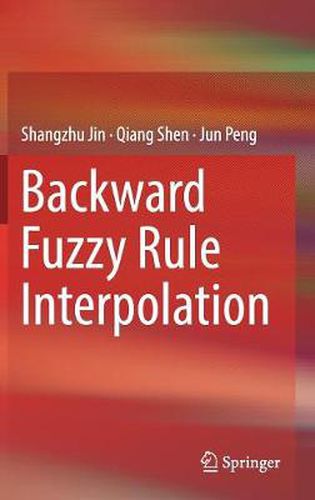Readings Newsletter
Become a Readings Member to make your shopping experience even easier.
Sign in or sign up for free!
You’re not far away from qualifying for FREE standard shipping within Australia
You’ve qualified for FREE standard shipping within Australia
The cart is loading…






This title is printed to order. This book may have been self-published. If so, we cannot guarantee the quality of the content. In the main most books will have gone through the editing process however some may not. We therefore suggest that you be aware of this before ordering this book. If in doubt check either the author or publisher’s details as we are unable to accept any returns unless they are faulty. Please contact us if you have any questions.
This book chiefly presents a novel approach referred to as backward fuzzy rule interpolation and extrapolation (BFRI). BFRI allows observations that directly relate to the conclusion to be inferred or interpolated from other antecedents and conclusions. Based on the scale and move transformation interpolation, this approach supports both interpolation and extrapolation, which involve multiple hierarchical intertwined fuzzy rules, each with multiple antecedents. As such, it offers a means of broadening the applications of fuzzy rule interpolation and fuzzy inference. The book deals with the general situation, in which there may be more than one antecedent value missing for a given problem. Two techniques, termed the parametric approach and feedback approach, are proposed in an attempt to perform backward interpolation with multiple missing antecedent values. In addition, to further enhance the versatility and potential of BFRI, the backward fuzzy interpolation method is extended to support -cut based interpolation by employing a fuzzy interpolation mechanism for multi-dimensional input spaces (IMUL). Finally, from an integrated application analysis perspective, experimental studies based upon a real-world scenario of terrorism risk assessment are provided in order to demonstrate the potential and efficacy of the hierarchical fuzzy rule interpolation methodology.
$9.00 standard shipping within Australia
FREE standard shipping within Australia for orders over $100.00
Express & International shipping calculated at checkout
This title is printed to order. This book may have been self-published. If so, we cannot guarantee the quality of the content. In the main most books will have gone through the editing process however some may not. We therefore suggest that you be aware of this before ordering this book. If in doubt check either the author or publisher’s details as we are unable to accept any returns unless they are faulty. Please contact us if you have any questions.
This book chiefly presents a novel approach referred to as backward fuzzy rule interpolation and extrapolation (BFRI). BFRI allows observations that directly relate to the conclusion to be inferred or interpolated from other antecedents and conclusions. Based on the scale and move transformation interpolation, this approach supports both interpolation and extrapolation, which involve multiple hierarchical intertwined fuzzy rules, each with multiple antecedents. As such, it offers a means of broadening the applications of fuzzy rule interpolation and fuzzy inference. The book deals with the general situation, in which there may be more than one antecedent value missing for a given problem. Two techniques, termed the parametric approach and feedback approach, are proposed in an attempt to perform backward interpolation with multiple missing antecedent values. In addition, to further enhance the versatility and potential of BFRI, the backward fuzzy interpolation method is extended to support -cut based interpolation by employing a fuzzy interpolation mechanism for multi-dimensional input spaces (IMUL). Finally, from an integrated application analysis perspective, experimental studies based upon a real-world scenario of terrorism risk assessment are provided in order to demonstrate the potential and efficacy of the hierarchical fuzzy rule interpolation methodology.